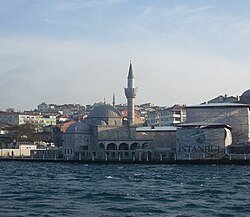Şemsi Pasha Mosque
| Şemsi Pasha Mosque | |
|---|---|

Şemsi Pasha Mosque, view from the sea.
|
|
| Basic information | |
| Location | Istanbul, Turkey |
| Geographic coordinates | 41°01′33″N 29°00′41″E / 41.02583°N 29.01139°E |
| Affiliation | Islam |
| Architectural description | |
| Architect(s) | Mimar Sinan |
| Architectural type | Mosque |
| Groundbreaking | 1580 |
| Completed | 1581 |
| Specifications | |
| Minaret(s) | 1 |
| Materials | granite, marble, tiles |
The Şemsi Pasha Mosque (Turkish: Şemsi Paşa Camii, also spelled Chamsi-Pasha) is an Ottoman mosque located in the large and densely populated district of Üsküdar, in Istanbul, Turkey.
The Şemsi Pasha Mosque was designed by Ottoman imperial architect Mimar Sinan for Grand Vizier Şemsi Pasha. The Mosque is one of the smallest to be commissioned by a Grand Vizier in Constantinople, however it is its miniature dimensions combined with its picturesque waterfront location which have made it one of the most attractive mosques in the city. The Mosque is a celebrated example of the chief architect's skill in organically blending architecture with the natural landscape.
The complex stands on a roughly rectangular site aligned east-west with the Bosphorus shoreline. The square, single domed mosque abuts the coast at an angle, with the adjoining mausoleum of the donor projecting towards the waterfront. The garden, which over-looks the Bosphorus, is surrounded on two sides by the madrasa, with the mosque on the third side and the sea wall on the fourth. The mosque itself is unusual in that the tomb of Şemsi Ahmet is joined to the main building, divided from the interior by a grille. The chamber is crowned by a mirror vault at the height of the prayer hall drum. It has three casement windows facing the Bosphorus and nine upper windows on three walls, adorned with coloured glass. Surrounding the Mosque is a larger complex, situated on the coast of Üsküdar, also built by court architect Sinan near the Şemsi Pasha Palace and, according to the inscription over the mosque portal, construction was completed in 1580. In 1940, an extensive restoration project was undertaken by the General Directorate of Religious Endowments, supervised by architect Süreyya Yücel. The complex stands on a roughly rectangular site aligned east-west with the Bosphorus shoreline. The square, single domed mosque abuts the coast at an angle, with the adjoining tomb of the donor projecting towards the waterfront. Its precinct is enclosed by an L-shaped madrasa to the west and south, and a seawall with grill-windows to the north, giving the impression that one is in a picture gallery looking at framed Bosphorus seascapes. The complex has two gates, one facing the land and the other facing the sea; the land gate opens to a private walled cemetery which occupies the eastern precinct, behind the mosque's qibla wall, which has become a burial site for generations of Şemsi Pasha.
...
Wikipedia
